We're back with another list, and this one reaches the northernmost point in the United States.
*Editor's note: This story originally ran Oct. 18, 2012 and has been re-dated for July 25, 2014. No content was changed.It's back!
On Aug. 7, we revealed
10 high school football stadiums to see before you die. But it didn't take us long to realize that we could find 10 more, with some help from reader comments on the first edition.
Once again we looked from coast to coast and asked all around, looking for those special 10 spots that you absolutely must go see. And we've got a great variety once again.
So take a little trip with us, and be sure to click on the link in each slide (except two) that takes you to even more photos. Furthermore, leave comments if we're missing any. Maybe there will be another list of 10 in the near future....
Lahainaluna High: Lahaina, Hawaii
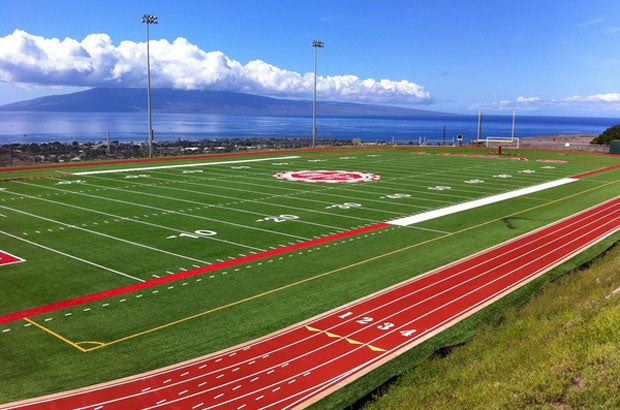
The athletics complex at Lahainaluna High is still a work in progress. What is already built, and is there to stay, is the view that is worthy of a postcard.
Photo courtesy of Lahainaluna High School
is still in the process of completing its new sports complex, but its
football field already presents a breathtaking view of the Pacific
Ocean.
The school is located in the West Maui region and is
isolated from the rest of the island by the West Maui Mountains. It was
founded by missionaries in 1831 as a seminary to train native Hawaiian
men as teachers. It's often referred to as the oldest school west of the
Mississippi and has the state's only public-school boarding program.
Athletic Director Scott Soldwisch pointed out, "The most unique thing is that
it's cut into the side of the West Maui Mountains overlooking the
Pacific Ocean. It's a very beautiful view. The sun will be going down
over the Pacific during the JV game."
Though the Lunas have a
rich football tradition, they were without a home field for many years,
having to travel as far as 25 miles one way at times. They were able to
play two home games in both 2010 and 2011 and are playing a bigger schedule
this year.
By the 2013 season, Soldwisch said the seating will
be expanded from 1,500 to 3,000, and a press box and concession stands
will be added to complete the facility. Considering the view from the field, all that other stuff is just icing on the cake.
More photos of Lahainaluna's field{PAGEBREAK}
Berry Center Stadium: Cypress, Texas
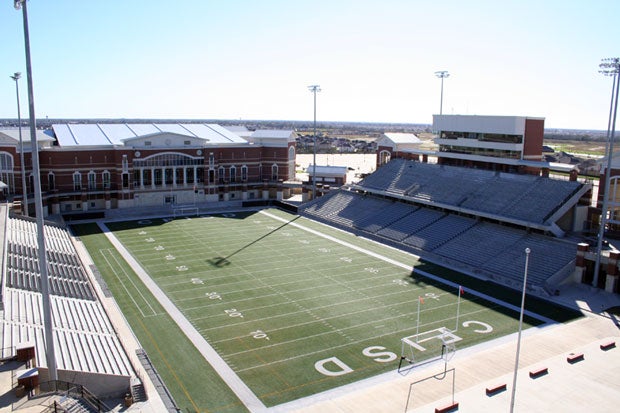
Schools from the Cypress-Fairbanks Independent School District get to share the jaw-dropping Berry Center facility, which includes an arena and numerous meeting rooms.
Photo courtesy of the Berry Center
The Richard E. Berry Educational
Support Center is actually five facilities in one. It includes an
11,000-seat stadium, 456-seat theater, 9,500-seat multipurpose arena,
conference center and satellite food production center.
The Berry
Center was part of a $470.5 million bond referendum. Its cost was $84
million and opened in 2006 on a 65-acre site in Cypress, Texas, near Houston.
The
facility was necessary due to the area's rapid growth and the cost of
renting facilities for graduation and other major events, which ran into
the thousands of dollars each year. For example, in 2005 graduation
ceremonies at a rented stadium cost the Cy-Fair community an estimated
$170,000.
All 10 schools in the district play their home games
at either the Berry Center or at the district's other field, Ken
Pridgeon Stadium.
More photos of the Berry Center {PAGEBREAK}
Cathy Parker Field: Barrow, Alaska

Barrow High has an ocean view, just like Lahainaluna. The difference is that Barrow borders the Arctic Ocean. You won't find a harsher locale for football in America.
Photo courtesy of Courtney Hammond
Whaling and football mix quite well in
Barrow (Alaska), with special thanks to ESPN and Cathy Parker.
An
ESPN writer traveled to Barrow and did a story on the local high school
football team, the Barrow Whalers. The story earned an Emmy and
spotlighted the plight of the Whalers, who were playing football on a
large patch of dirt.
Cathy Parker, a mother and football fan
from Florida, read the story and was inspired to start a fundraising
campaign that produced more than $500,000 to build the Whalers a real
football field. In honor of her heroic efforts, the colorful (blue and
yellow turf) facility is called Cathy Parker Field.
The field
is located 3 miles south of the northernmost point of land in the
United States and is open to constant cold, blustery winds and
occasional snow flurries.
"On a flat stretch of land, with the Chukchi Sea a hundred yards to the west, the tundra of the North Slope to the east and nothing but a couple
miles standing between the field and the northernmost point of land in
the U.S., this 'stadium' is unlike any
other I have been to," said Courtney Hammond, who spent time in Barrow while studying at the Dickey Center Institute of Arctic Studies. "Instead of enclosing spectators and players
within the stadium, here, both spectators and players are completely
exposed to the Arctic elements and the beauty of the horizon in all
directions."
It's not unusual for spectators to
watch a football game, then journey less than a mile to watch whaling
captains bring in their hauls.
More photos of Cathy Parker Field{PAGEBREAK}
Roosevelt Stadium: Union City, N.J.
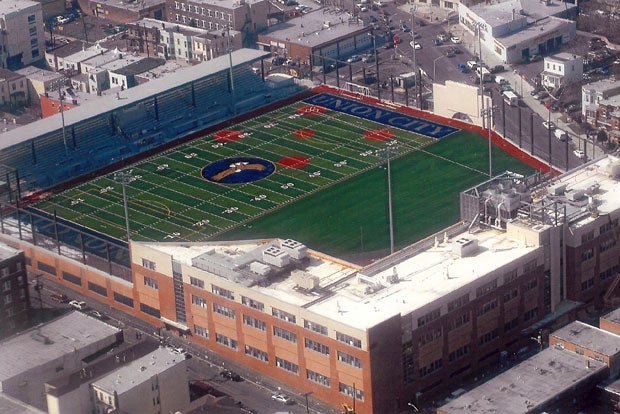
When you can't build outward, you have to build up. That's the lesson learned at Union City High, where they came up with a unique setup in the nation's densest city.
Photo courtesy of Union City High School
probably is the only high school in the country with its football field resting on the roof.
When the new school was built - consolidating Emerson and Union Hill - there was no room for a football stadium because Union City (population 66,455) is the most densely populated city in the country with 51,810 people per square mile.
The school, which is surrounded by private homes and businesses, rests on the site of the former Roosevelt Stadium, which was a 1937 public works project. The third-floor stadium presents a breathtaking view of the Empire State Building and Midtown Manhattan.
The stadium has been nicknamed "Eagle's Nest" in honor of its new mascot, a soaring eagle. It seats 2,500 and has artificial turf. The school cost $180 million, with $15 million of that going toward the stadium. There is a 40-foot high net in each end zone to catch attempted field goals and extra points. Since the first game in 2009, only two footballs and one soccer ball have been lost, according to Athletic Director Dave Clauser.
Baseballs have provided a more serious situation, however, because Clauser noted that one nearby neighbor has had the windshield of his car broken three times.
The most unusual incident came in October of the first year, when a fire alarm forced the evacuation of an estimated 700 fans at halftime. During a playoff game last year, capacity of 2,500 was reached early and 1,500 very unhappy fans were left mulling around in the street below until they got tired and went home.
The NFL Play for 60 camp for ages 9-13 was held at the stadium. It targeted obesity and the ensuing diabetic problem and drew 300 entries, mostly from Hudson County. The Seattle Seahawks and San Francisco 49ers have practiced at the stadium prior to games in New York as well.
{PAGEBREAK}
Little Rose Bowl: West Branch, Iowa
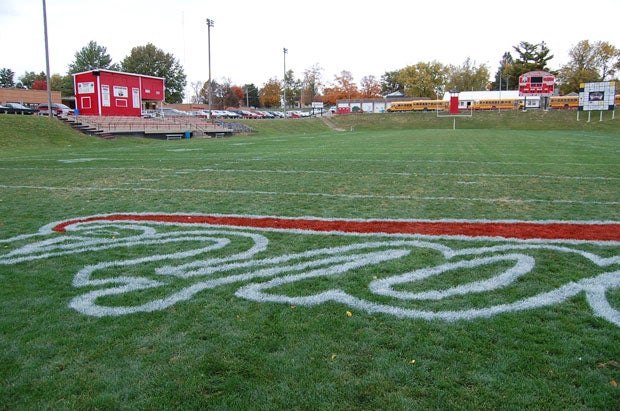
Nobody will confuse the Little Rose Bowl with the actual Rose Bowl in Pasadena, Calif. Still, the West Branch, Iowa venue holds a special place in the heart of Iowa football fans.
Photo courtesy of the West Branch Times
Though it's also referred to as Oliphant Street Field, it has been the "Little Rose Bowl" to many generations of football fans in
West Branch (Iowa).
"It was dredged out (in the shape of a bowl) by local residents in the early 1900s by teams of horses and mules," veteran football coach Butch Pedersen related. "We have guardrails and people sit on them. They set out chairs on Wednesday for a Friday night game. They sit on lawn chairs, blankets and the top of their cars. We are surrounded by people. It's a really cool atmosphere. It's the center of our community."
The high school is about a half mile from the field and actually has a nice, much-newer football field, which is used strictly for practice. A move to use the new field for games, however, was strongly voted down because of strong tradition and the windy conditions at the new field, which is on a hill.
Game night is a sight to behold. The players get off the bus and walk down Oliphant Street to the field - all holding hands with cleats clicking on the pavement.
"It's a rush," Pedersen said. "People have come from out of town just to watch the walk. The booster club has painted bear (team mascot) prints in the street. Some people have bear prints on their driveways. It's been a football town since Moses, (maybe not quite that long)."
Pedersen noted that in his 30 years as head coach, the Bears have won 90 percent of their home games and 80 percent overall with three Class A state titles. They once won 62 consecutive regular-season games, the second-longest streak in Iowa history, and had an 81-point game.
During the winter the Little Rose Bowl still is the center of West Branch, because young and old alike sled down the sides of the hill.
More photos of the Little Rose Bowl{PAGEBREAK}
Paul Brown Tiger Stadium: Massillon, Ohio
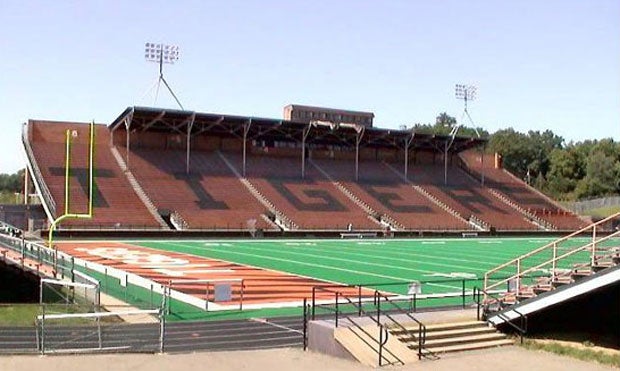
If you want history, and quality Ohio prep football, then Paul Brown Tiger Stadium is the place to be. The venue's 75th anniversary is approaching fast.
Photo courtesy of Washington High Football
When high school football is discussed, no school has more tradition than
Washington (Massillon, Ohio).
Much of that tradition can be traced to the legendary Paul Brown, who played and coached there and was greatly responsible for building the famed Tiger Stadium, which also now bears his name. Brown graduated in 1925 and returned to coach at age 23. He compiled a spectacular 80-8-2 record with six state titles before taking over at Ohio State University, then coaching the NFL's Cleveland Browns and Cincinnati Bengals.
The stadium was built in 1939 and seats 19,000. The press box seats 120, on par with many college and pro facilities. Each Washington home game is a colorful event, featuring a famous marching band, parades, bonfires and a live Tiger mascot. Many town fire hydrants are decorated with tiger stripes.
The Tigers have won 22 state championships and one of their greatest players, linebacker Chris Spielman, was featured on Wheaties boxes when he was 16 years old.
The mammoth showplace also has been used for NFL Hall of Fame events and numerous state playoff games.
More photos of Paul Brown Tiger Stadium{PAGEBREAK}
Kezar Stadium: San Francisco
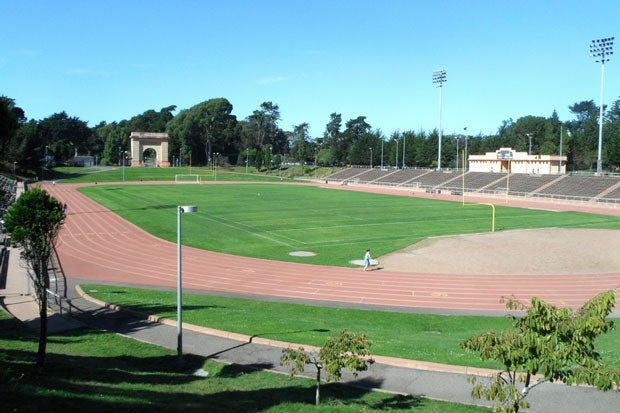
Kezar Stadium's allure isn't the physical atmosphere. It's the history (both football and music) plus location in Golden Gate Park that make it a must-see.
Photo courtesy of Darek Truesdale
Kezar Stadium, located in San Francisco's Golden Gate Park, once was home to the NFL's San Francisco 49ers and Oakland Raiders. It was built in one year at a cost of $300,000 and dedicated in 1925.
Over the years it has been used for such diverse sports as track & field, motorcycle and auto racing, rugby, lacrosse, soccer, baseball, boxing and cricket. For several years, Stanford University held its spring football game at Kezar. Other college games have been played there, as well as the East-West Shrine Game.
In 1928, the City Championship prep game between Lowell and Polytechnic drew a crowd of 50,000. However, starting in 1989, it was torn down and rebuilt with a seating capacity of 10,000.
Today it still gets great use from high school football teams. For example, the Turkey Bowl for the city championship has been played there for many years. It also is home to
Sacred Heart Cathedral (San Francisco) and
Mission (San Francisco).
Many famous concerts have been held at Kezar, which is about a 10-minute walk from the famous Haight-Ashbury intersection. Bands like Led Zeppelin, The Doobie Brothers, Waylon Jennings, Jefferson Starship, Tower of Power and the Grateful Dead have dazzled crowds at the locale, which gets socked in by thick fog often. In 1971, several scenes from the Clint Eastwood movie "Dirty Harry" were filmed there as well.
{PAGEBREAK}
Pendleton Round-Up: Pendleton, Oregon

Football is second-best at the Pendleton Round-Up, one of the world's most famous rodeo venues. It's perhaps the nation's most unique combination-style venue.
Photo courtesy of Debbi Green
The
Pendleton (Ore.) football team has the unique experience of playing its home games in the arena of one of the top rodeos in the world. It seats 17,000 and traces its history to 1910. The Round-Up Association rents the field to the school, which is just one-half mile away if one takes the foot bridge over the river instead of driving.
Rodeo week annually swells the town's population from 15,000 to at least 50,000. Football players often are awed when they picture all the great cowboys who have performed on the same field. It's no wonder the team is nicknamed the Buckaroos.
Home fans are seated in the south grandstand, while visitors are seated over the bucking chutes. Some believe the latter seats are the best in the house.
Dust is not a major problem, according to Pendleton athletic secretary Anita Lewis, because the Round-Up is one of the select rodeo sites with a grass infield.
A unique home-field advantage, coupled with a steady run of talent, enabled coach Don Requa to win 301 games - No. 5 in state history - from 1951-1986, and carve out a niche in the Oregon Hall of Fame.
More photos of the Pendleton Round-Up{PAGEBREAK}
Mitchell Stadium: Bluefield, W.Va.
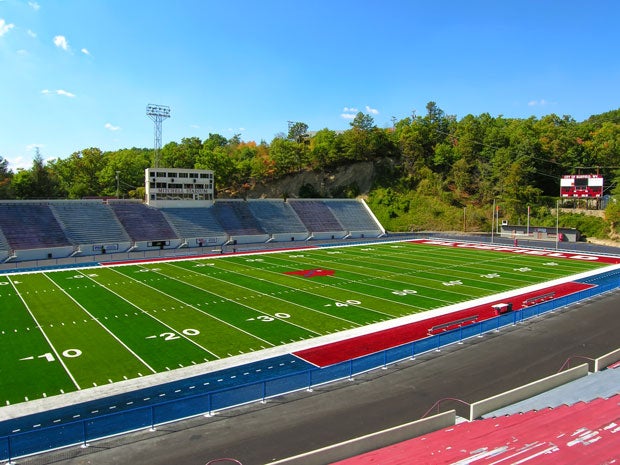
You might be able to kick a ball from a tee in Mitchell Stadium and see it land in another state. The lush surroundings and unique location make it a must-see.
Photo courtesy of Mark Robinette
Mitchell Stadium has a unique claim that probably is unmatched: It is the home field for high school football teams in two states.
The 10,000-seat stadium was built in
Bluefield (W. Va.), but a border school,
Graham (Bluefield, Va.), also calls it home. It was built in 1935 by the Works Progress Administration and is located in Bluefield's city park. It was named in honor of Bluefield city manager Emory P. Mitchell, who campaigned tirelessly for a city park, pool, auditorium, football and baseball fields and tennis courts.
There was a time when Bluefield could not produce the matching funds to get the government grant, so Mitchell and his family signed a personal note enabling the city to borrow enough money and continue the stadium project. The stadium was dedicated to him on Oct. 23, 1954, more than three years after his death.
West Virginia University and Virginia Tech, as well as Bluefield College, have played games at Mitchell Stadium, which is also used for music events.
More photos of Mitchell Stadium{PAGEBREAK}
Union Tuttle Stadium: Tulsa, Okla.
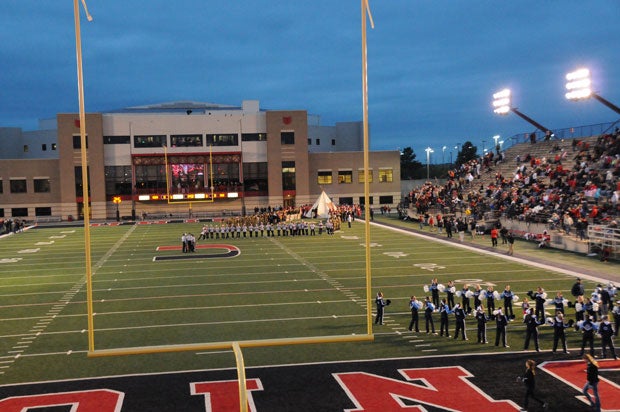
Looking for atmosphere? Come to Tulsa and see the Union vs. Jenks matchup. Union's home stadium sometimes isn't big enough to host the annual rivalry game.
Photo courtesy of Union High School
The $1.7 million stadium, which seats 11,000, had a glorious dedication on Sept. 24, 1976. Speakers included a member of the Unites States House of Representatives, a future U.S. senator and a Cherokee Indian chief, who blessed the stadium.
However, the Redskins are believed to have lost their first 14 games in their new palace until they finally got on the victory trail. Once they got there, though, they never looked back. They even put together a 56-game winning streak at home until it was broken by Hoover (Ala.), then the No. 1-ranked team in the nation. They have won eight state titles and finished second five times.
The school has grown from 500 students in grades 9-12 to 4,200 - the state's second-largest school. In 1985, Union was the first school in Oklahoma to install artificial turf. In 1990 the stadium was renamed in honor of assistant football coach Phil Tuttle, who was killed in a 1988 car accident.
Union and Jenks have combined to win the last 16 Class 6A state titles. Their rivalry is so big that games often have been moved to the University of Tulsa. The rivalry has been named No. 1 in the nation by Sports Illustrated and one meeting drew a crowd of more than 40,000.
More photos of Union Tuttle Stadium